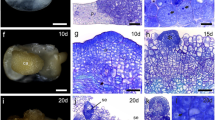Summary
Developing protophloem sieve elements in roots of wheat are arranged in single vertical files. In the last immature differentiating sieve element bearing ribosomes the proximal end of the cytoplasm displays a diluted appearance in contrast to the distal end where the cytoplasm exhibits a considerably increased electron density. Differences can also be observed in ribosome quantity, organelle ultrastructure and the time of initiation of cell component degradation, those at the proximal end disorganizing first, suggesting a nonsimultaneous disorganization of the cell components in the two areas. This phenomenon, termedheterochronic lysis, is presumably an expression of an existing polarity not detectable in younger stages, but it might also be the result of an asynchronous enzymatic activity.
Similar content being viewed by others
Abbreviations
- CW:
-
Cell wall
- D:
-
dictyosome
- ER:
-
endoplasmic reticulum
- M:
-
mitochondrion
- N:
-
nucleus
- P:
-
plastid
- SE:
-
sieve element
- SP:
-
sieve plate
References
Apostolakos P, Galatis B (1987) Induction, polarity and spatial control of cytokinesis in some abnormal subsidiary cell mother cells ofZea mays. Protoplasma 140: 26–42
Behnke H-D (1969) Aspekte der Siebröhren. Differenzierung bei Monocotylen. Protoplasma 68: 289–314
— (1981) Siebelement-Plastiden, Phloem-Protein und Evolution der Blütenpflanzen: II. Monokotyledonen. Ber Deutsch Bot Ges 94: 647–662
Danilova MF, Telepova MN (1978) Differentiation of protophloem sieve elements in seedling roots ofHordeum vulgare. Phytomorphology 28: 418–431
— — (1982) Distinctive features of differentiation in proto- and metaphloem sieve elements of barley root. Phytomorphology 30: 380–387
Eleftheriou EP (1984) Sieve element plastids ofTriticum andAegilops (Poaceae). Pl Syst Evol 145: 119–133
— (1985) Microtubules and root protophloem ontogeny in wheat. J Cell Sci 75: 165–179
— (1986) Ultrastructural studies on protophloem sieve elements inTriticum aestivum L. Nuclear degeneration. J Ultrastruct Mol Struct Res 95: 47–60
— (1987 a) Microtubules and cell wall development in differentiating protophloem sieve elements ofTriticum aestivum L. J Cell Sci 87: 595–607
— (1987 b) Changes in the endoplasmic reticulum during sieve element differentiation inTriticum aestivum. Ann Bot 60: 713–721
—, Tsekos I (1982 a) The ultrastructure of protophloem sieve elements in leaves ofAegilops comosa var. thessalica. Ann Bot 49: 557–567
— — (1982 b) Developmental features of cell wall formation in sieve elements of the grassAegilops comosa var. thessalica. Ann Bot 50: 519–529
— — (1982 c) Development of protophloem in roots ofAegilops comosa var. thessalica. I. Differential divisions and pre-prophase bands of microtubules. Protoplasma 113: 110–119
— — (1982 d) Development of protophloem in roots ofAegilops comosa var. thessalica. II. Sieve-element differentiation. Protoplasma 113: 221–233
Esau K, Gill RH (1971) Aggregation of endoplasmic reticulum and its relation to the nucleus in a differentiating sieve element. J Ultrastruct Res 34: 144–158
— — (1972) Nucleus and endoplasmic reticulum in differentiating root protophloem ofNicotiana tabacum. J Ultrastruct Res 41: 160–170
— — (1973) Correlations in differentiation of protophloem sieve element ofAllium cepa root. J Ultrastruct Res 44: 310–328
Evert RF (1977) Phloem structure and histochemistry. Ann Rev Plant Physiol 28: 199–222
Fjell I (1987 a) Ultrastructural features of differentiating protophloem sieve elements in adventitious roots ofSalix viminalis. Nordic J Bot 7: 135–151
— (1987 b) P-protein and inclusion bodies in root protophloem ofSalix viminalis. Nordic J Bot 7: 305–310
Gunning BES (1976) The role of plasmodesmata in short distance transport to and from the phloem. In: Gunning BES, Robards AW (eds) Intercellular communication in plants: studies on plasmodesmata. Springer, Berlin Heidelberg New York, pp 203–227
Hoefert LL (1979) Ultrastructure of developing sieve elements inThlaspi arvense L. I. The immature state. Am J Bot 66: 925–932
— (1980) Ultrastructure of developing sieve elements inThlaspi arvense L. II. Maturation. Am J Bot 67: 194–201
Karnovsky MJ (1965) A formaldehyde-glutaraldehyde fixation of high osmolarity for use in electron microscopy. J Cell Biol 27: 137 A-138 A
Kawahara H, Matsuda T, Chonan N (1980) Studies on morphogenesis in rice plant. XII. Ultrastructure of the phloem in the crown root (Jap). Jap J Crop Sci 49: 330–339
Kawata S, Morita S, Yamazaki K (1978) On the differentiation of vessels and sieve tubes at the root tips of rice plants (Jap). Jap J Crop Sci 47: 101–110
Kuo J (1983) The nacreous walls of sieve elements in seagrasses. Am J Bot 70: 159–164
Melaragno JE, Walsh MA (1976) Ultrastructural features of developing sieve elements inLemna minor L. The protoplast. Am J Bot 63: 1145–1157
Schnepf E (1986) Cellular polarity. Ann Rev Plant Physiol 37: 23–47
Singh AP (1980) On the ultrastructure and differentiation of the phloem in sugarcane levels. Cytologia 45: 1–31
Thorsch J, Esau K (1981) Ultrastructural studies of protophloem sieve elements inGossypium hirsutum. J Ultrastruct Res 75: 339–351
— — (1982) Microtubules in differentiating sieve elements ofGossypium hirsutum. J Ultrastruct Res 78: 73–83
Walsh MA (1980) Preservation of the tonoplast in metaphloem sieve elements of embryonic roots ofZea mays L. Ann Bot 46: 557–565
—, Evert RF (1975) Ultrastructure of metaphloem sieve elements inZea mays. Protoplasma 83: 365–388
—, Melaragno JE (1981) Structural evidence for plastid inclusions as a possible “sealing” mechanism in the phloem of monocotyledons. J Exp Bot 32: 311–320
Warmbrodt RD (1985) Studies on the root ofHordeum vulgare L.-Ultrastructure of the seminal root with special reference to the phloem. Am J Bot 72: 414–432
Author information
Authors and Affiliations
Rights and permissions
About this article
Cite this article
Eleftheriou, E.P. An unusual feature of developing protophloem sieve elements in roots ofTriticum aestivum L.. Protoplasma 152, 14–21 (1989). https://doi.org/10.1007/BF01354235
Received:
Accepted:
Issue Date:
DOI: https://doi.org/10.1007/BF01354235




